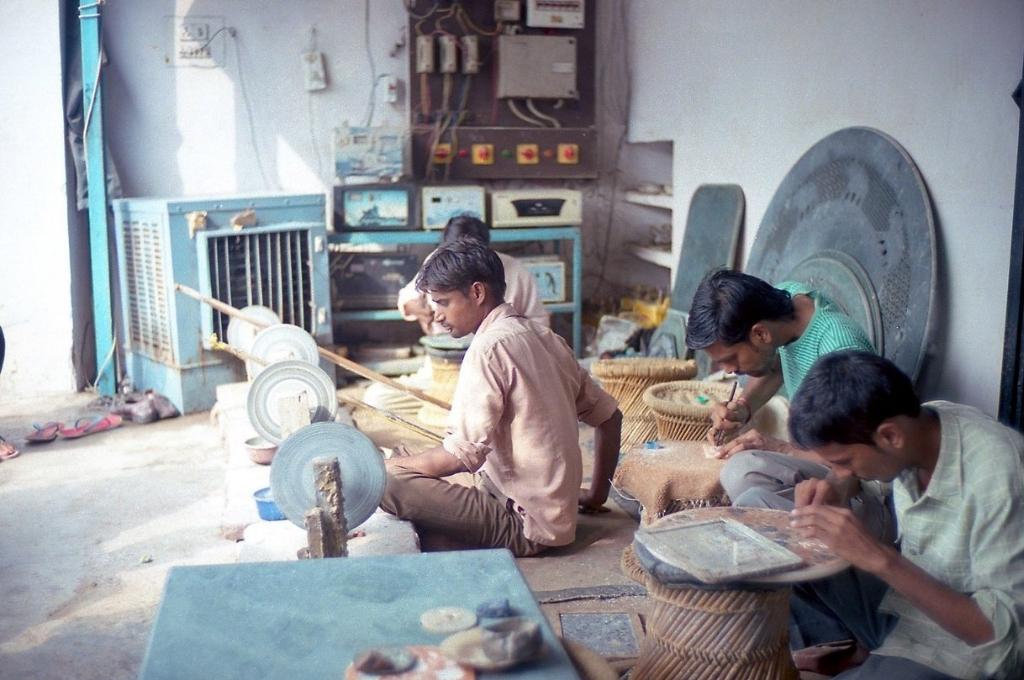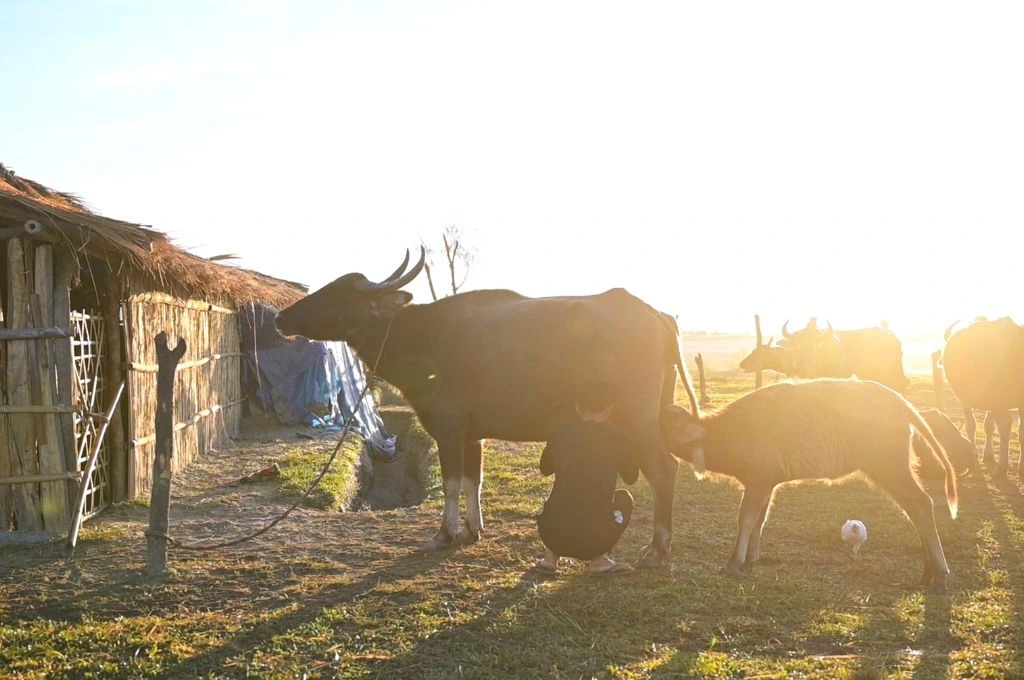As we head into 2022, India still lacks good quality data on migrant workers, rules for new labour codes that were passed in Parliament almost a year ago are yet to be finalised, budgetary provisions for the rural jobs programme have fallen short of demand for work, and the government told Parliament that no committee has yet been formed to draft a National Employment Policy (NEP).
The unemployment rate in urban areas, which had seen a large exodus of migrant workers after the nationwide lockdown was imposed in March 2020, had decreased to pre-lockdown levels, at 9.4% in the first quarter of 2021, according to data from the Periodic Labour Force Survey. India’s economy is also seeing a recovery, with the gross domestic product growing at 8.4% in the second quarter of 2021-22 compared to 7.4% during the same period last year.
But overall employment levels fell again from April to June 2021, per Centre for Monitoring Indian Economy (CMIE) data, after several states imposed lockdowns to control the Covid-19 second wave. With the economic recovery, by November 2021, employment nationwide had improved to pre-second wave levels.

But behind this improvement in employment numbers lie increased work and wage insecurity, with many workers falling back on more precarious self-employment or informal work, experts told IndiaSpend during the peak of the second Covid-19 wave in May 2021.
Even before the pandemic, general unemployment was a cause for concern, reaching a 45-year high in 2019. India was witnessing increased informalisation of jobs as firms fired workers because they could not afford to keep them on the payroll, or saw an opportunity to reduce labour costs, before the pandemic-induced economic recession, experts said, and the second wave made the situation worse.
Over the last two years, millions of jobs have been lost and workers’ livelihoods, particularly in the informal and unorganised sector, have been adversely impacted by measures to control the Covid-19 pandemic. As we move into a year where uncertainty over the threat of the Omicron variant of concern and a possible third wave looms, we assess the status of the workforce and labour and employment policies in India.
Dearth of good quality data on workers
Well before the advent of the Covid-19 pandemic, in August 2018, the Supreme Court (SC) had ordered the government to create a national portal for registering unorganised workers so that they could access welfare benefits. Unorganised workers make up the vast majority of India’s workforce, at 93%. In June 2021, nearly three years after its order, the SC, while responding to a petition on issues migrant workers faced after the Covid-19 lockdown was imposed, noted the delay in setting up the portal, and said that while unorganised workers were awaiting registration and attendant welfare benefits, the “lackadaisical attitude by the Ministry of Labour and Employment is unpardonable”.

The e-Shram portal, launched on August 26, 2021, had registered 130 million workers of a targeted 380 million by December 22. Over two-thirds of India’s informal workforce are thus yet to be registered. Moreover, the informal workforce per some estimates is higher than the government’s target. For instance, it was 415.6 million-strong in 2018-19, per Azim Premji University’s State of Working India (SWI) 2021 report. Workers were facing challenges during registration, including due to mandated use of Aadhaar-linked mobile numbers, IndiaSpend reported in November 2021.

Since the lockdown-induced reverse migration, the condition of migrant workers, many of whom work in the informal economy, has been a cause of concern. It is estimated that nearly 11.4 million migrants have returned home till date. Yet, even two years after the Covid-19-induced lockdown, gaps in data on migrant workers persist despite efforts to step up data gathering. The government told Parliament in December 2021 that it has limited information on migrant workers.
In February 2021, the government announced surveys of migrant workers, domestic workers, employment generated by professionals and in the transport sector, and last, an all-India quarterly establishment-based employment survey, which would cover both organised and unorganised sectors. In September, the government released the last survey. On November 22, it flagged off the domestic workers survey, given “dearth of data on the magnitude and prevailing employment conditions of domestic workers”.
“These surveys, if properly executed and the data released on time, would be a very important addition to our understanding of the Covid-19 pandemic’s economic impact and recovery, considering the data-poor climate when it comes to estimating the impact on workers and households,” Amit Basole, economist at APU’s Centre for Sustainable Employment in Bengaluru, told IndiaSpend.
The lack of credible data on numbers of migrant workers pose challenges for migrant welfare policy creation, IndiaSpend reported in March 2021.
Even two years after the COVID-19-induced lockdown, gaps in data on migrant workers persist.
In April 2021, the government launched the All India Survey of Migrant Workers, but this was stalled until mid-July due to the Covid-19 second wave. During a May 31, 2020 radio address Prime Minister Narendra Modi said that the government was considering setting up a migration commission. But on December 6, 2021, the government informed parliament “there is no proposal to set up [a] Migration Commission”, adding only that its policy think-tank Niti Aayog had submitted a report on preparing a National Action Plan for Migrant Workers. Meanwhile, the government continues to share data from a decade-old census in responses to Parliament on questions related to migrant workers’ welfare.
The e-Shram portal was expected to register migrant workers and enable access to welfare entitlements “anytime anywhere“, but less than 3% of workers who had registered by early November were migrant workers. Since then, data on migrant workers are no longer visible on the e-Shram public dashboard. “The registration system was mandated by the Supreme Court and was aimed at registering circulatory migrants, but the e-Shram portal captures migration data only if the migrant is a semi-permanent migrant and is confined to one vocation,” Ravi Srivastava, director of the Centre for Employment Studies, told IndiaSpend in November.
Rural jobs programme remains underfunded
The pandemic-affected years of 2020 and 2021 reported the highest number of individuals who got work under the rural jobs programme, the Mahatma Gandhi National Rural Employment Guarantee Scheme (MGNREGS), at 112 million and 92 million, respectively, as of December 24, 2021. By that date, the number of individuals working was 17% more than reported in 2019-20, indicating the continuing demand for MGNREGS work in rural areas, despite an improvement in the economy in the second quarter of 2021-22. About 111 million persons have demanded work in 2021-22, 19 million more than those provided with work.
Inadequate fund allocation has led to negative MGNREGS balance in states.
Even as the number of people seeking work in 2020-21 increased to 133 million, the highest ever, the government allocated 35% less funds for the programme in 2021-22 and was unwilling to provide more than the 100 days of work MGNREGS provides for, IndiaSpend reported in August 2021. Immediately after the Union budget 2021 was released, experts said that the MGNREGS allocation was insufficient given increased demand for work in rural areas due to the Covid-19 pandemic.
Inadequate fund allocation has led to negative MGNREGS balance in states. Of 34 states and UTs on the MGNREGS Management Information System, 25 had negative balance–meaning more money was spent than allocated–amounting to an overall negative balance of Rs 10,585 crore ($1.4 billion) indicating insufficient funds for the scheme. Andhra Pradesh had the highest negative balance at nearly Rs 2,111 crore, followed by Karnataka at Rs 1,431 crore.
The central government allocated an additional Rs 10,000 crore for MGNREGS as an “interim measure” in November 2021, and more funds may be released based on assessment of demand at the stage of preparing revised estimates for the Union budget 2021, per the Ministry of Rural Development.
Across India, more than 7% of wage payments (Rs 2,850 crore) were pending approval from the Centre, for work done between April and September 2021, IndiaSpend reported in November 2021. Workers in the Bundelkhand region spanning parts of Uttar Pradesh and Madhya Pradesh had complained of payment delays and inadequate allocation of work days, IndiaSpend reported in August 2021.
Rules based on new Labour Codes not ready
The government notified four labour codes pertaining to workers’ welfare–the Code on Wages 2019, the Industrial Relations Code 2020, the Occupational Safety, Health and Working Conditions Code 2020 and the Code on Social Security, in March 2021. The first was passed by Parliament in July 2020 and the last three in September 2020. Over a year later, Union and state government rules based on the new labour codes are still being drafted, the Ministry of Labour and Employment told Parliament on December 16, 2021. “The Central Government and some of the States/UTs have pre-published rules under the four Labour Codes. The Central Government is pursuing with the remaining State Governments to frame the rules under all four Codes,” the labour ministry said.
Rules based on the Code on Wages have been pre-published by 24 of 36 states/UTs, Industrial Relations Code rules by 20, Code on Social Security rules by 18 and Occupational Safety, Health and Working Conditions Code rules by 13 of the 36 states/UTs, per the labour ministry.
The Covid-19 pandemic has exposed the vulnerability of workers and the intention to rationalise the complex system of labour legislation is needed, but the labour codes were “brought hastily in the middle of the pandemic”, said Basole.
The rules made by the government are still in the draft stage and are incomplete, as it has not made rules concerning recognition of central trade union organisations, K.R. Shyam Sundar, professor at the Xavier School of Management in Jamshedpur, told IndiaSpend. “Concrete provisions must be made in the social security fund. Gig and platform workers must be included in all codes and in the workers’ definition,” he said.
“The government is least likely to implement the labour codes till the completion of the assembly elections,” said Sundar. IndiaSpend has written to senior officials at the Ministry of Labour and Employment on the challenges around finalising rules and whether these were delayed due to upcoming state elections. We will update the article when we hear from them.
Lack of social security
As of 2020, only 46.9% of the global population was effectively covered by at least one social protection while the rest–nearly 4.1 billion people–were left wholly unprotected, according to the International Labour Organization’s (ILO) World Social Protection Report (WSPR) 2020–22. In India, more than 90% work in the informal economy, indicating work and income insecurity among more than 415 million informal sector workers, per SWI 2021. The absence of rules excludes millions of workers from basic social security, including those who work in the gig economy, per SWI 2021 and WSPR-2020-22. In December 2021, the Supreme Court asked for the government’s response to a writ petition seeking social security rights for gig workers employed by taxi service and online food delivery aggregators, among others.
High income inequality is correlated with low levels of social mobility and slower poverty reduction, widening inequalities, per a 2021 ILO report. In 2021, the wealthiest 10% of the population owned 65% of total household wealth in India, according to the World Inequality Report 2022. Inequality can be reduced by social security transfers. Also, gender inequalities in India “are very high”, it added. At 18%, the female labour income share was lower than the average in Asia (21%, excluding China).
A lack of clarity about the benefits of e-Shram registration may be hampering registration of more workers.
Although one of the main objectives of e-Shram registration is to facilitate delivery of social security schemes and portablity of such schemes for migrant workers, only accidental insurance cover of Rs 2 lakh for a year free of cost is available as of now. A lack of clarity about the benefits of e-Shram registration may be hampering registration of more workers, labour welfare experts had told us.
“E-shram should, as and when it is completed, provide some information for providing targeted social security and social assistance programmes,” said Sundar.
Further, many migrant workers who came back to cities to work after the first Covid-19 lockdown ended were facing job insecurity and scanty savings post the second Covid-19 wave, causing them to return to their home states again, IndiaSpend reported in June 2021. Lessons from the pandemic must be taken seriously, especially when it comes to short-term and circular migrants, who constitute the most vulnerable section of informal workers, said Basole.
“Migrant workers have paid a very high cost indeed. I don’t think enough has been done since last year on this front,” said Basole.
In addition, only 1% of firms in India’s micro, small and medium enterprises sector, a large employer of informal workers including migrants, which took a big economic hit during the pandemic, qualified for government support under the Atmanirbhar Bharat Abhiyaan package, IndiaSpend reported in December 2021. Amid the adverse economic impact of the second wave, the government should think of an urban employment guarantee programme on the lines of the rural jobs programme, especially for women, experts had told us in May.
No clarity on a national employment policy
In February 2021, the central minister of state for labour and employment said that five all-India surveys, including ones on domestic and migrant workers, and professionals, were being conducted by the ministry’s labour bureau, to provide a comprehensive estimate of India’s employment and unemployment scenario, thereby formulating a “sound National Employment Policy” (NEP).
A roadmap for a National Employment Policy (NEP) reportedly was to be formulated by December 2021. There is no clarity yet, however, on NEP. “At present there is no Committee for drafting of National Employment Policy”, the ministry told Parliament on December 2, and referred again to the all-India surveys.
“A national employment policy should promote decent work, in which international labour standards, social protection and workers’ fundamental rights go hand in hand with job creation,” the ILO had said in 2015. “This [NEP] is urgently needed,” said Basole. Consultations between the government and experts have been going on for several months and there are many ideas for creating productive jobs in various sectors which can be comprehensively brought together by an NEP, he added.
Sundar feels that surveys must be a secondary pursuit, as they would provide some valuable information and the government, perhaps, is waiting for the results of the surveys to decide NEP, said Sundar. “Employment policy must be integral to the macro economic policies of the government and its absence hurts the labour market outcomes and hence the economy in general.”
The SWI 2021 proposed a framework for NEP, which included the promotion of public investment in social infrastructure as well as the facilitation of private investment. There is a need to move “from a scheme-based to legal entitlement-based approach that provides a rights-based universal social protection floor for the unorganised sector..,” it added.
IndiaSpend has asked the government when an NEP will be finalised. We will update the story when we receive a response.
This article was originally published on IndiaSpend, a data-driven, public-interest journalism nonprofit.





